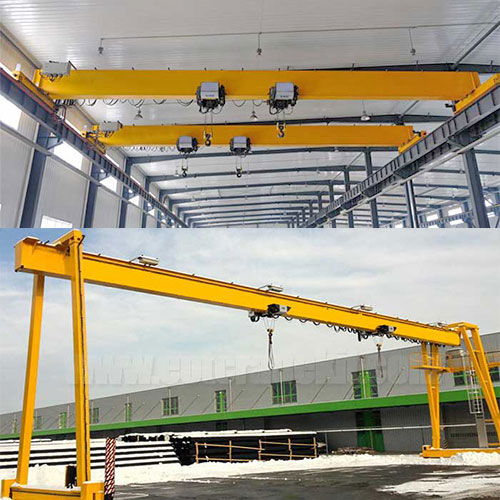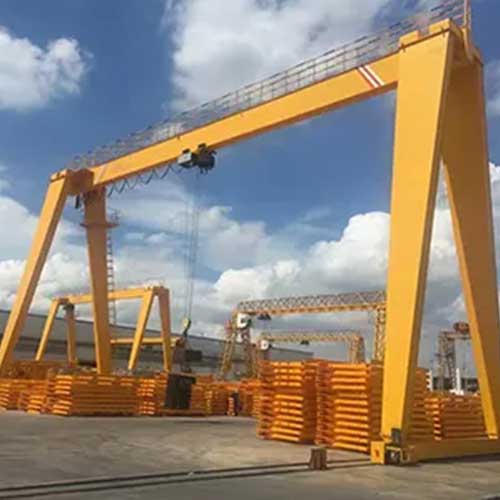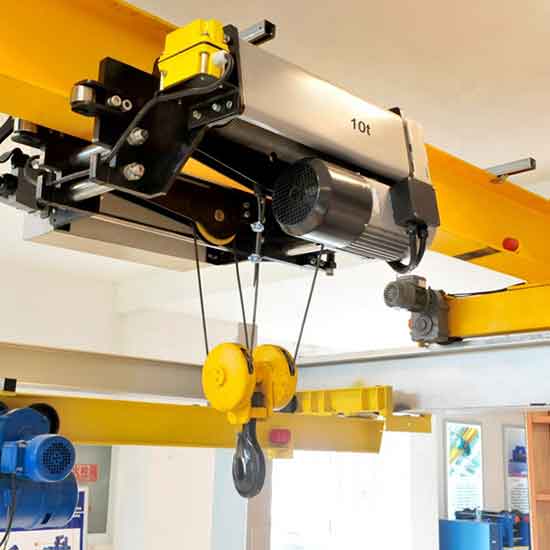Double Hoist Crane with Two Hooks for Tandem & Separate Control
Double hoist overhead crane & gantry crane for sale. Double hoist crane, Single girder & Double girder crane with Two Hooks for Tandem & Separate Control.
Category: Overhead Hoist
Your Trusted Double Hoist Overhead Crane Manufacturer & Supplier
Double Hoist Crane with Two Hooks for Tandem & Separate Control
Double Hoist Overhead Cranes & Gantry Crane with Two Hooks for Sale 3 Ton + 3 Ton to 50 Ton + 50 Ton
Double hoist overhead crane & gantry crane for sale. Double hoist crane, Single girder & Double girder Crane with Two Hooks for Tandem & Separate Control.
Maximizing Efficiency and Performance with Double Hoist Cranes: A Comprehensive Guide
In the realm of material handling and industrial operations, the innovation and integration of advanced technologies have led to significant enhancements in efficiency and productivity. One such innovation, the double hoist crane, stands at the forefront of modern industrial lifting solutions. This comprehensive guide aims to delve into the intricacies of double hoist cranes, offering a detailed understanding of their functionality, applications, benefits, and considerations for potential buyers and users.
Double hoist cranes, a pinnacle of lifting equipment, consist of a specialized design featuring two hoists operating in tandem. These cranes are engineered to facilitate the lifting and movement of substantial loads with enhanced precision, efficiency, and versatility. The dual hoisting mechanism enables simultaneous lifting and positioning of materials, allowing for increased productivity and improved operational capabilities.
The evolution of double hoist crane technology has been marked by remarkable advancements, transforming the landscape of industrial lifting and material handling. From rudimentary lifting systems to sophisticated, precision-driven machinery, the journey of double hoist cranes reflects the relentless pursuit of efficiency and safety in industrial operations.
Early iterations of hoisting mechanisms primarily focused on single-hoist systems, limiting the capacity and efficiency of lifting operations. However, the advent of double hoist crane technology brought about a paradigm shift. The integration of synchronized dual-hoist systems revolutionized the lifting capacities, enabling industries to handle heavier loads with heightened precision and safety measures.
Advancements in engineering, material science, and control systems have further refined double hoist cranes. The utilization of robust materials, such as high-strength alloys and precision-engineered components, has bolstered the reliability and durability of these cranes. Additionally, sophisticated control systems and automation have empowered operators with precise control over lifting operations, significantly reducing human error and enhancing safety protocols.
The continuous evolution and innovation in double hoist crane technology underscore their pivotal role in modern industrial settings. These cranes have become indispensable assets across various industries, revolutionizing material handling, and significantly contributing to operational efficiency.
In the subsequent sections of this comprehensive guide, we will delve deeper into the various facets of double hoist cranes. We will explore their types, advantages, applications across industries, key considerations for selection, installation, maintenance, and much more. By the end of this guide, you'll have a comprehensive understanding of the role and significance of double hoist cranes in industrial operations.
Types of Double Hoist Cranes
Exploring the Diversity in Double Hoist Crane Designs
Double hoist cranes are not a one-size-fits-all solution; rather, they come in various configurations and designs tailored to meet specific industrial needs. Understanding the different types of double hoist cranes is crucial for selecting the most suitable option based on operational requirements.

Single Girder Double Hoist Overhead Crane
The single girder double hoist overhead crane features a single bridge girder with two hoists mounted on it. This design offers a balance between functionality and cost-effectiveness, making it a popular choice in numerous industries. It is particularly adept at handling moderate to heavy loads efficiently and is suitable for applications where a higher hook height is required.
Features:
- Utilizes a single girder design with two hoists operating in tandem.
- Suitable for moderate to heavy lifting requirements.
- Offers efficient material handling capabilities in limited headroom spaces.
Benefits:
- Cost-effective solution compared to double girder cranes.
- Ideal for applications with lighter loads but requiring dual lifting points.
- Suitable for workshops, warehouses, and assembly lines.
Typical Applications:
- Manufacturing facilities for lifting lighter loads in a compact space.
- Warehouses and storage areas where headroom is restricted.

Double Girder Double Hoist Overhead Crane
In contrast, the double girder double hoist overhead crane incorporates two bridge girders with dual hoists running on each girder. This robust design significantly enhances load-bearing capabilities and provides increased stability, making it ideal for heavy-duty lifting operations. Industries dealing with extremely heavy loads or requiring longer spans often prefer this type of crane due to its superior strength and lifting capacity.
Features:
- Employs two girders with two hoists operating in synchronization.
- Offers robustness and higher lifting capacities compared to single girder cranes.
- Provides enhanced stability for heavier loads and longer spans.
Benefits:
- Superior lifting capabilities for heavier materials or larger spans.
- Increased stability ensures safer and more precise lifting operations.
- Suitable for heavy-duty applications with demanding lifting requirements.
Typical Applications:
- Heavy manufacturing environments like steel mills or foundries.
- Construction sites for handling large prefabricated structures.

Single Girder Double Hoist Gantry Crane
The single girder double hoist gantry crane bears similarities to its overhead counterpart but operates on a gantry structure rather than a fixed overhead runway. This design offers portability and flexibility, enabling its usage in outdoor settings and areas lacking permanent overhead support structures. It's commonly employed in shipyards, construction sites, and outdoor fabrication operations where mobility is essential.
Features:
- Utilizes a single girder design with two hoists operating on a gantry frame.
- Offers flexibility in movement and lifting capabilities.
- Suitable for outdoor applications with no overhead support.
Benefits:
- Versatile for varied load handling with dual lifting points.
- Provides mobility and flexibility for outdoor operations.
- Ideal for construction sites, shipyards, or outdoor material yards.
Typical Applications:
- Construction sites for handling materials without permanent support structures.
- Outdoor storage yards or logistics centers for versatile material handling.

Double Girder Double Hoist Gantry Crane
Similar to the overhead counterpart, the double girder double hoist gantry crane features two girders and dual hoists. However, this variant operates on a gantry structure, providing enhanced stability and lifting capabilities. It is suitable for heavy-duty applications in outdoor settings, such as shipping yards and construction sites, requiring precise and simultaneous lifting operations.
Features:
- Employs two girders with two hoists on a gantry frame.
- Offers higher stability and lifting capacities compared to single girder gantry cranes.
- Provides robustness and precision in handling heavier loads.
Benefits:
- High lifting capacities for heavy materials in outdoor settings.
- Enhanced stability and precision for critical lifting operations.
- Suitable for heavy-duty applications requiring outdoor mobility.
Typical Applications:
- Shipbuilding facilities for handling large ship components.
- Heavy machinery and equipment handling in open yards.

Portable Double Girder Hoist Cranes
Portable double girder hoist cranes offer the flexibility of mobility combined with the strength of a dual hoist system. These cranes are designed to be easily movable, allowing them to cater to multiple workstations or locations within a facility. Their versatility makes them valuable assets in industries requiring frequent repositioning of lifting equipment.
Features:
- Designed for portability with double girders and dual hoists.
- Offers mobility and flexibility for temporary lifting needs.
- Can be transported and assembled in different locations.
Benefits:
- Flexibility in deployment for temporary projects or diverse workstations.
- Enables efficient material handling in areas lacking fixed crane systems.
- Suitable for construction sites, temporary workshops, or maintenance operations.
Typical Applications:
- Construction projects with varying lifting requirements.
- Temporary workshops or maintenance facilities needing adaptable lifting solutions.
Crane Control of Double Hoist Cranes
Optimizing Operations through Control Mechanisms
The functionality and efficiency of double hoist cranes are greatly influenced by their control systems, allowing operators to manage lifting operations with precision and safety. Understanding the two primary control mechanisms—Tandem Control and Separate Control—provides valuable insights into the operational capabilities of double hoist cranes.
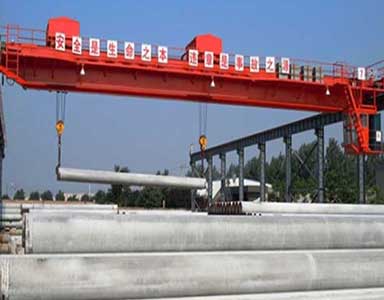
Tandem Control of Double Hoists
Tandem control involves synchronizing the movement of both hoists to lift a single load simultaneously. This method ensures that both hoists operate in unison, maintaining a balanced lift and precise positioning of the load. Tandem control is particularly beneficial when handling heavy or bulky items, as it distributes the load evenly between the hoists, preventing imbalance and ensuring stability during lifting and movement.
The synchronized movement facilitated by tandem control enhances operational efficiency and reduces the risk of load sway, contributing to safer and more controlled material handling processes. This control method is commonly employed in scenarios requiring coordinated lifting of large or irregularly shaped objects.
Features:
- Simultaneous Operation: Tandem control enables both hoists to operate together, lifting and moving loads in synchronization.
- Equal Load Distribution: Ensures even weight distribution between the hoists, maintaining balance and stability during lifting operations.
- Increased Lifting Capacity: Allows for lifting heavier loads by combining the lifting capacities of both hoists.
Benefits:
- Enhanced Lifting Performance: Simultaneous operation enhances lifting performance, enabling the handling of heavier or more cumbersome loads efficiently.
- Improved Stability and Control: Maintains load balance, minimizing sway or tilting, ensuring safer and more controlled lifting and movement.
- Optimized Workflow: Enables quicker and more efficient lifting operations, enhancing productivity in material handling tasks.
Typical Applications:
- Heavy Industries: Found in industries dealing with exceptionally heavy loads such as steel manufacturing, shipbuilding, or heavy machinery production.
- Construction Sites: Used for lifting and positioning large prefabricated components or heavy construction materials.
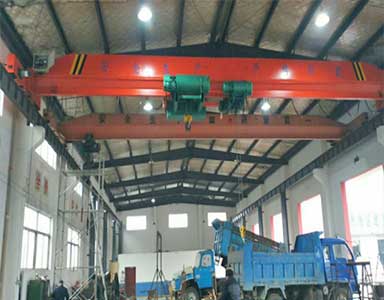
Separate Control of Double Hoists
In contrast to tandem control, separate control allows operators to manipulate each hoist independently. This control mechanism grants operators the flexibility to lift and move multiple loads simultaneously, albeit in different directions or at varying speeds. Separate control provides versatility in handling diverse loads with different weight distributions or when performing multiple lifting tasks concurrently.
The ability to control each hoist separately enables precise positioning and intricate material handling operations, offering adaptability in scenarios where loads require different handling techniques or when working with several objects simultaneously.
Features:
- Individual Hoist Control: Allows independent control of each hoist, enabling varied lifting operations or load placements.
- Flexibility in Operations: Offers the ability to lift or lower loads at different speeds or heights independently.
- Versatility in Load Handling: Allows for handling asymmetric loads or situations where one side requires more control than the other.
Benefits:
- Versatility and Adaptability: Provides flexibility in handling diverse load types, shapes, or sizes by adjusting each hoist's operation independently.
- Precise Load Positioning: Offers precise control for placing loads in specific locations or adjusting load balance when necessary.
- Enhanced Safety Measures: Enables operators to manage unevenly distributed loads more effectively, reducing the risk of accidents.
Typical Applications:
- Warehousing and Logistics: Used for handling irregularly shaped or unbalanced cargo in warehouses or logistics centers.
- Manufacturing Processes: Beneficial in assembly lines requiring precise positioning or manipulation of components with differing weights.
Tandem Control of Double Hoists:
Load Characteristics:
- Heavier Loads: Tandem control is advantageous for handling exceptionally heavy loads that require the combined lifting capacities of both hoists.
- Large and Bulky Objects: Suitable for lifting and transporting large and cumbersome objects that may exceed the capacity of a single hoist.
Operational Requirements:
- Synchronized Lifting: Essential for applications requiring simultaneous and synchronized lifting of extremely heavy loads to maintain stability and balance.
- Precise Load Positioning: Required for accurately placing heavy objects or materials in specific positions or locations.
Examples:
- Heavy Machinery Components: Such as large engine parts, industrial equipment, or machinery components in manufacturing or production settings.
- Metal Structures: Used for lifting and positioning large steel beams or structures in construction or metalworking industries.
Separate Control of Double Hoists:
Load Characteristics:
- Asymmetric Loads: Ideal for handling unevenly distributed or asymmetrical loads that may require different lifting actions on each side.
- Varied Weight Distribution: Suitable for objects with differing weight distributions that necessitate independent control of each hoist.
Operational Requirements:
- Varied Lifting Speeds: Necessary for operations where different lifting speeds or heights are required for each hoist to manage uneven loads effectively.
- Fine Load Adjustment: Required for precise load positioning or adjusting the balance of loads with varying weight distributions.
Examples:
- Irregularly Shaped Objects: Handling loads with irregular shapes or weight distribution in logistics or warehousing environments.
- Assembly Line Operations: Useful for manipulating components of different weights or shapes along assembly lines, requiring precise placement or adjustments.
Tandem control of double hoists is well-suited for handling exceptionally heavy and large loads, ensuring synchronized lifting and stability, while separate control offers versatility in managing asymmetrical loads or objects with varying weight distributions, providing precise and independent control over each hoist. The typical loads or objects handled and operational requirements vary based on the specific capabilities and advantages offered by each control method.
The choice between tandem control and separate control depends largely on the nature of the lifting tasks, the characteristics of the loads, and the operational requirements of the specific industrial application. Both control mechanisms have their distinct advantages, empowering operators with tailored approaches to manage lifting operations efficiently and safely.
Featured Application of Double Hoist Cranes:
Double hoist cranes, with their diverse configurations and capabilities, find extensive applications across various industries. Their adaptability and efficiency make them indispensable in handling a wide range of loads and meeting specific operational requirements.
Typical Applications of Double Hoist Cranes
- Manufacturing Sector: In manufacturing facilities, double hoist cranes play a vital role in streamlining production processes. They facilitate the movement of heavy machinery components, assisting in assembly lines and ensuring seamless production operations. These cranes contribute significantly to just-in-time manufacturing by efficiently transporting materials to the required workstations, optimizing workflow, and reducing downtime.
- Construction and Infrastructure Projects: Double hoist cranes are indispensable in construction sites, aiding in the erection and installation of structural elements. They handle heavy construction materials such as steel beams, concrete panels, and prefabricated components, contributing to the timely completion of projects. Their ability to lift and position substantial loads with precision enhances productivity and safety during construction activities.
- Warehousing and Logistics: In warehouse environments, double hoist cranes streamline inventory management and logistics operations. They assist in the movement of pallets, containers, and bulky items, optimizing storage and retrieval processes. These cranes are pivotal in managing goods within warehouses, facilitating efficient distribution and cargo handling, thereby reducing manual labor and operational time.
Typical Loads Handled by Double Hoist Cranes
Double hoist cranes exhibit the capability to handle a wide array of loads, including but not limited to:
- Heavy machinery components in manufacturing facilities
- Structural steel elements and prefabricated materials in construction sites
- Pallets, containers, and bulk items in warehouse environments
- Engines, molds, and large equipment in industrial settings
The lifting capacities, precision, and versatility of double hoist cranes make them suitable for handling various loads across industries. Their ability to adapt to different load sizes, shapes, and weights is a testament to their efficiency and suitability for diverse applications.
Why Double Hoists Operationed is Required ?
The implementation of double hoists in various application conditions and loads handling scenarios is primarily driven by specific operational needs and the nature of the materials or objects being handled. Several reasons and operational requirements justify the use of double hoists in these applications:
Enhanced Lifting Capacity and Load Handling:
- Heavy and Bulky Loads: In scenarios where lifting exceptionally heavy or bulky loads is required, double hoists provide the necessary capacity to handle these materials efficiently. They distribute the weight more evenly, ensuring stability and reducing the strain on individual hoists, allowing for safer and more controlled lifting operations.
- Increased Efficiency in Material Handling: Double hoists allow for the lifting and movement of multiple loads simultaneously or a single large load with greater precision and speed. This capability significantly enhances operational efficiency by reducing handling times and optimizing workflow in industries where time-sensitive operations are crucial.
Versatility and Flexibility:
- Simultaneous Handling of Multiple Loads: The ability to control each hoist independently or synchronize their movements enables the handling of multiple loads in different directions or at varied speeds. This versatility is advantageous in applications where diverse materials or objects need to be lifted, positioned, or transported concurrently.
- Adaptability to Varied Industrial Settings: Double hoist cranes, particularly those designed for portability or operation in open spaces, offer adaptability to different industrial environments. They can efficiently cater to various workstations within a facility or operate in outdoor settings where fixed overhead systems might not be feasible.
Precision and Safety:
- Enhanced Control and Stability: Using double hoists, especially in tandem control, provides greater control and stability during lifting operations. This helps prevent load sway and ensures more accurate positioning of materials, reducing the risk of accidents and enhancing safety measures in handling heavy or irregularly shaped objects.
- Meeting Specific Industrial Requirements: Industries such as manufacturing, construction, and logistics often deal with specialized loads or intricate handling needs. Double hoists, with their tailored functionalities and capacities, meet these specific requirements, ensuring efficient and safe material handling processes.
Increased Productivity and Cost Efficiency:
- Optimizing Workflow: Double hoists contribute to streamlining operations, reducing downtime, and optimizing workflow in manufacturing, construction, and warehousing environments. They enable faster and more efficient material handling, leading to increased productivity and cost savings in the long run.
- Just-in-Time Manufacturing and Logistics: In industries requiring precision and timeliness, such as just-in-time manufacturing or time-sensitive logistics, double hoist cranes facilitate the swift movement of materials, aiding in meeting strict production or delivery schedules.
The utilization of double hoists in various application conditions and loads handling scenarios is a strategic choice aimed at optimizing operational efficiency, ensuring safety, and meeting specific industrial requirements. Their capabilities to handle heavy loads, provide versatility, enhance precision, and contribute to increased productivity make them indispensable assets in diverse industrial settings.
Advantages of Double Hoist Cranes
Double hoist cranes offer a multitude of advantages that significantly impact industrial operations, providing a competitive edge in efficiency, versatility, and handling capabilities compared to single hoist systems.
Increased Lifting Capacity:
- Comparative Analysis with Single Hoist Systems: Double hoist cranes outperform single hoist systems when it comes to lifting heavier loads. By utilizing two hoists operating in tandem, these cranes distribute the load weight more effectively, minimizing strain and ensuring stability during lifting operations. This enhanced capacity allows industries to handle heavier and bulkier materials that might exceed the lifting capabilities of single hoist cranes.
- Scalability and Handling Heavier Loads: The design of double hoist cranes allows for scalability in lifting capacities, making them suitable for a wide range of load sizes and weights. Whether it's managing exceptionally heavy machinery components in manufacturing or large structural elements in construction, the increased lifting capacity of double hoist cranes provides the flexibility needed to handle diverse materials efficiently.
Enhanced Efficiency in Material Handling:
- Simultaneous Operations and Load Management: The ability to lift and control two loads independently or synchronously sets double hoist cranes apart. This capability enables simultaneous operations, facilitating the handling of multiple loads or a single large load with precision. Industries benefit from the reduced handling times, optimized load distribution, and better management of materials, contributing to enhanced operational efficiency.
- Impact on Workflow and Productivity: Double hoist cranes play a pivotal role in streamlining workflow and boosting productivity. By efficiently managing material handling processes, these cranes minimize downtime, optimize production lines, and support just-in-time manufacturing practices. The increased efficiency translates into higher productivity, enabling industries to meet deadlines and improve overall operational output.
Versatility and Flexibility in Operations:
- Multi-Tasking Capabilities and Diverse Applications:The versatility of double hoist cranes allows for multi-tasking capabilities, handling different loads simultaneously or performing varied lifting operations. Whether it's lifting materials of different shapes, sizes, or weights or conducting multiple tasks in parallel, these cranes provide a level of adaptability that is crucial in industries with diverse handling requirements.
- Adaptability to Varied Industrial Settings: From manufacturing facilities to construction sites and warehouse environments, double hoist cranes showcase adaptability across different industrial settings. Their design, whether overhead or gantry, offers flexibility in deployment, making them suitable for indoor and outdoor applications. This adaptability ensures that these cranes can cater to the specific needs of varied industrial environments.
The advantages offered by double hoist cranes, including increased lifting capacity, enhanced efficiency in material handling, and their versatile operational capabilities, make them indispensable assets across a spectrum of industries. Their impact on handling heavier loads, optimizing workflow, and adapting to diverse operational needs underscores their significance in modern industrial settings.
Applications and Industries
Double hoist cranes find extensive applications across diverse industries, facilitating efficient material handling and contributing to streamlined operations in various sectors:
Manufacturing Sector:
- Role in Production Lines and Assembly Processes: Double hoist cranes are instrumental in the manufacturing sector, aiding in the movement and positioning of heavy machinery components along production lines. They ensure a smooth assembly process, facilitating the timely completion of products.
- Just-in-Time Manufacturing and Inventory Management: These cranes contribute to just-in-time manufacturing practices by facilitating the swift movement of materials. They assist in managing inventory efficiently, ensuring that materials are available precisely when needed, minimizing excess inventory and storage costs.
Construction and Infrastructure Projects:
- Efficient Handling of Building Materials: In construction projects, double hoist cranes efficiently handle building materials such as steel beams, concrete panels, and prefabricated components. They aid in transporting these heavy materials across construction sites, streamlining the construction process.
- Role in Construction and Erection Phases: Double hoist cranes play a vital role in erecting structures by lifting and positioning heavy structural elements with precision. Their capability to handle substantial loads contributes to the efficient completion of construction phases.
Warehousing and Logistics:
- Inventory Management and Storage Solutions: Within warehouse environments, double hoist cranes assist in inventory management by lifting and placing pallets, containers, and bulk items. They optimize storage solutions by efficiently organizing and storing materials within the warehouse space.
- Streamlining Distribution and Cargo Handling: These cranes streamline distribution operations by efficiently handling cargo and facilitating its movement within logistics centers. They contribute to quicker loading and unloading of goods, enhancing the efficiency of logistics operations.
The versatility and adaptability of double hoist cranes make them indispensable across various industries. From aiding production lines in the manufacturing sector to streamlining construction processes and optimizing logistics operations, these cranes play pivotal roles, contributing to enhanced efficiency and productivity across different industrial domains.
Key Features to Consider When Choosing a Double Hoist Crane
Choosing the right double hoist crane involves evaluating specific features and functionalities crucial for its effective operation in industrial settings. Here are key considerations:
Lifting Capacity and Load Range:
- Matching Crane Capacities to Specific Industry Needs: Assess the required lifting capacities and load ranges based on the materials or objects to be handled. Ensure that the crane's capacity aligns with the weight and size of the loads typically encountered in your industry.
Hoist Speed and Precision:
- Importance in Time-Sensitive Operations: Evaluate the hoist speed to determine its suitability for time-sensitive operations. Consider the crane's precision in positioning and movement, especially when dealing with delicate or intricate materials.
Safety Features and Compliance:
- Regulatory Standards and Safety Measures: Ensure that the double hoist crane complies with industry safety standards and regulations. Evaluate safety features such as limit switches, emergency stop systems, and overload protection to mitigate potential hazards.
- Accident Prevention Systems and Technologies: Consider additional safety technologies, such as anti-sway systems or collision avoidance features, to enhance safety measures and prevent accidents during lifting and movement operations.
Durability and Maintenance:
- Factors Affecting Longevity and Reliability: Assess the crane's durability by examining the quality of materials used in its construction. Consider factors like corrosion resistance, robustness, and structural integrity to ensure long-term reliability.
- Maintenance Requirements and Serviceability: Evaluate the crane's maintenance needs and serviceability. Opt for cranes that offer ease of maintenance, availability of spare parts, and reliable servicing to minimize downtime and ensure smooth operations.
Carefully considering these key features when selecting a double hoist crane is crucial in ensuring that the chosen crane aligns with the specific operational requirements of your industry. By evaluating lifting capacity, speed, safety features, durability, and maintenance aspects, industries can make informed decisions, optimizing the performance and efficiency of double hoist cranes within their operations.
Double Hoists Overhead Crane with Two Hooks
An overhead crane with double hoists and two hooks features a robust design equipped with two independent hoisting mechanisms, each fitted with its hook. This configuration allows for simultaneous or separate lifting of multiple loads, offering enhanced efficiency and flexibility in material handling operations.
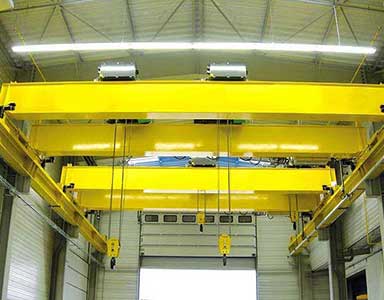
Double Girder Double Hoist Crane with Two Hooks:
Features:
- Two separate hoists mounted on a sturdy double girder structure.
- Dual hooks for lifting multiple loads independently or simultaneously.
Benefits:
- High lifting capacities suitable for heavy loads and oversized materials.
- Enhanced stability and precise load control due to the double girder design.
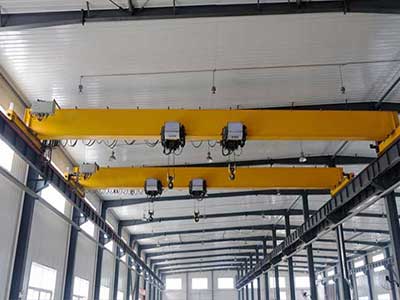
Single Girder Double Hoist Crane with Two Hooks:
Features:
- Single girder crane configuration with two hoists operating independently.
- Two hooks for handling medium to heavy loads with increased flexibility.
Benefits:
- Ideal for applications requiring moderate lifting capacities and restricted headroom.
- Cost-effective solution offering versatile lifting capabilities.
Applications:
- Manufacturing Industries: Used in assembly lines for lifting various components simultaneously.
- Construction Sites: Handling and positioning of heavy construction materials.
- Warehousing and Logistics: Efficient handling of palletized goods or multiple packages.
- Automotive Sector: Simultaneous handling of vehicle parts during assembly.
Advantages:
- Increased Productivity: Simultaneous handling of multiple loads reduces cycle times and enhances overall productivity.
- Flexibility and Versatility: Allows for diverse load configurations and handling requirements.
- Optimized Workflow: Streamlines material handling processes by lifting multiple items concurrently.
Overhead cranes equipped with double hoists and two hooks offer unparalleled versatility and efficiency in handling multiple loads. Whether it's the robustness of a double girder crane or the flexibility of a single girder configuration, these cranes cater to diverse industrial applications demanding simultaneous or independent lifting capabilities.
Single Girder Double Hoist Cranes vs. Double Girder Double Hoist Cranes
The comparison between single girder double hoist cranes and double girder double hoist cranes involves various factors, including their structural design, lifting capacities, applications, and suitability for specific industrial needs. Here's an in-depth comparison:
Structural Design:
Single Girder Double Hoist Crane:
- Structure: Equipped with a single bridge girder supporting two hoists.
- Space Requirement: Ideal for applications with limited headroom or space constraints.
- Versatility: Suited for moderate lifting capacities and versatile material handling tasks.
Double Girder Double Hoist Crane:
- Structure: Features two sturdy bridge girders, each supporting an independent hoist.
- Space Requirement: Requires more headroom but offers superior stability and higher lifting capacities.
- Suitability: Ideal for heavy-duty lifting operations and handling large, heavy loads.
Lifting Capacities:
Single Girder Double Hoist Crane:
- Capacity: Typically handles loads ranging from medium to heavy.
- Limitation: Limited maximum lifting capacity compared to double girder cranes.
Double Girder Double Hoist Crane:
- Capacity: Designed for handling heavier loads and oversized materials.
- Strength: Offers significantly higher lifting capacities compared to single girder cranes.
Applications:
Single Girder Double Hoist Crane:
- Industrial Use: Suitable for assembly lines, workshops, and warehouses with moderate lifting requirements.
- Versatility: Offers flexibility in various industries requiring adaptable material handling.
Double Girder Double Hoist Crane:
- Industrial Use: Commonly used in heavy manufacturing, steel mills, and construction sites.
- Heavy-Duty Operations: Provides stability and strength for handling massive machinery or oversized materials.
Cost Consideration:
Single Girder Double Hoist Crane:
- Cost-Effectiveness: Generally more cost-effective in terms of initial investment and maintenance.
- Efficiency: Offers efficient handling for medium-scale operations.
Double Girder Double Hoist Crane:
- Initial Investment: Usually higher initial investment due to its robust design and higher capacities.
- High-Intensity Operations: Suited for industries with demanding lifting requirements and heavy loads.
Single girder double hoist cranes excel in versatility, cost-effectiveness, and adaptability to moderate lifting tasks in confined spaces. Conversely, double girder double hoist cranes boast higher lifting capacities, superior stability, and strength, making them the ideal choice for heavy-duty applications requiring substantial load handling capabilities.
Benefits of Double Hoist Overhead Crane in Industrial Settings
Double hoist overhead cranes offer several advantages that significantly impact industrial operations, enhancing workflow, cost-effectiveness, and safety measures:
Optimizing Workflow and Productivity:
- Efficient Material Handling: Double hoist overhead cranes streamline material handling processes by efficiently lifting and transporting heavy loads. This optimization minimizes downtime, expedites operations, and ensures a smoother workflow along production lines.
- Enhanced Operational Efficiency: By enabling simultaneous operations or handling larger loads, these cranes contribute to increased efficiency in moving materials, reducing waiting times, and enhancing the overall productivity of industrial operations.
Cost-Effectiveness and Return on Investment (ROI):
- Long-Term Cost Savings: Despite the initial investment, double hoist overhead cranes offer long-term cost savings through their efficiency in handling heavier loads and optimizing workflow. They reduce labor costs and enhance operational output, resulting in improved ROI over time.
- Enhanced Operations for Increased ROI: The efficiency gains achieved by utilizing double hoist overhead cranes result in enhanced operations, allowing industries to meet deadlines effectively. This improved performance directly impacts the overall ROI of the industrial operations.
Safety Improvements and Risk Mitigation:
- Accident Prevention: Double hoist overhead cranes come equipped with safety features that mitigate risks, ensuring safer material handling operations. Features like overload protection and anti-sway systems minimize accidents and protect both equipment and personnel.
- Cultivating a Safer Work Environment: Implementing these cranes enhances safety measures, fostering a culture of safety within industrial settings. Reduced risks and accidents contribute to a safer work environment for employees, minimizing potential injuries and associated costs.
The utilization of double hoist overhead cranes in industrial settings offers multifaceted benefits, ranging from optimized workflow and enhanced productivity to substantial cost savings and improved safety measures. Their efficiency in material handling and risk mitigation contributes significantly to the overall operational efficiency and safety culture within industries.
Double Hoist Gantry Crane with Double Hooks
Gantry cranes equipped with double hoists offer enhanced lifting capabilities and flexibility in material handling operations. Here's an overview of the types of double hoist gantry cranes:
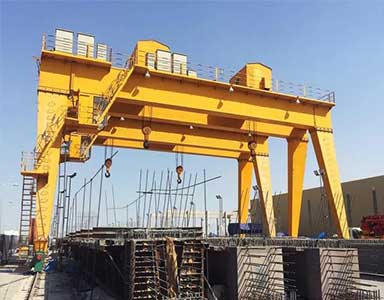
Double Girder Double Hoist Gantry Crane:
- Structure: Features two parallel girders supporting two hoists, each running on separate tracks mounted on the girders.
- Lifting Capacity: Offers high lifting capacities suitable for heavy loads and oversized materials.
- Applications: Commonly used in industries requiring robust lifting solutions, such as steel mills, shipyards, and heavy manufacturing, for handling large machinery and hefty components.
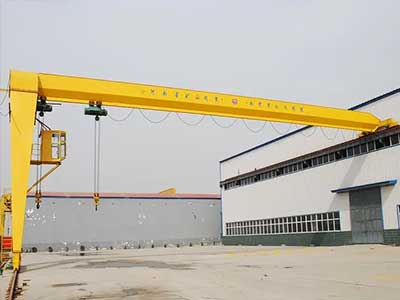
Single Girder Single Girder Double Hoist Gantry Crane:
- Structure: Incorporates a single girder supporting two hoists, providing a more compact and cost-effective design.
- Lifting Capacity: Suitable for medium to heavy loads, offering versatility in handling diverse materials.
- Applications: Finds usage in assembly lines, workshops, and warehouses where moderate lifting capacities are required, offering flexibility in material handling operations.
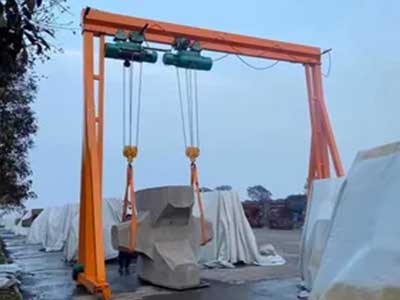
Portable Double Girder Hoist Cranes:
- Structure: Offers the flexibility of mobility with two hoists mounted on double girders, designed for easy relocation across different job sites.
- Lifting Capacity: Tailored for various load capacities, facilitating lifting operations in different environments.
- Applications: Ideal for construction projects, outdoor applications, or job sites requiring frequent relocation, providing versatile lifting solutions.
Double hoist gantry cranes come in various configurations, offering versatility, increased lifting capacities, and adaptability to diverse industrial applications. The choice between these types of cranes depends on specific lifting requirements, load capacities, and the operational environment.
Single Girder Double Hoist Gantry Cranes vs. Double Girder Double Hoist Gantry Cranes

Single Girder Double Hoist Gantry Crane:
Structure:
- Girder Configuration: Utilizes a single main girder to support two hoists for lifting operations.
- Compact Design: Takes up less space compared to double girder cranes, suitable for operations with limited headroom.
- Versatility: Offers flexibility for moderate lifting capacities and adaptable material handling tasks.
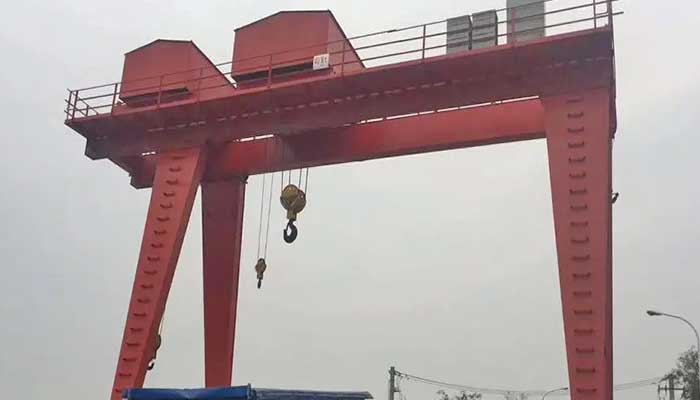
Double Girder Double Hoist Gantry Crane:
Structure:
- Girder Configuration: Features two parallel girders supporting two hoists, providing enhanced stability and strength.
- Lifting Capacity: Designed for heavier loads and oversized materials due to its robust structure.
- Stability: Offers superior stability and precise load control for heavy-duty lifting operations.
Comparative Analysis:
Lifting Capacities:
- Single Girder Crane: Suited for moderate to heavy loads, ideal for versatile material handling tasks in constrained spaces.
- Double Girder Crane: Offers significantly higher lifting capacities, suitable for heavy industrial applications requiring stability and strength.
Space Requirements:
- Single Girder Crane: Requires less headroom, making it suitable for facilities with height limitations or restricted space.
- Double Girder Crane: Requires more vertical space due to its double girder design but provides enhanced stability for heavy lifting.
Cost Consideration:
- Single Girder Crane: Typically more cost-effective in terms of initial investment and maintenance due to its simpler structure.
- Double Girder Crane: Involves a higher initial investment but offers greater lifting capacities and stability for heavy-duty applications.
Applications:
- Single Girder Crane: Commonly used in assembly lines, workshops, and warehouses with moderate lifting requirements.
- Double Girder Crane: Ideal for heavy manufacturing, steel mills, and construction sites dealing with larger, heavier loads.
Both single girder double hoist gantry cranes and double girder double hoist gantry cranes have their specific advantages and suitability based on lifting capacities, space constraints, and industrial applications. The choice between the two types depends on the unique lifting requirements, space availability, and budget considerations of the intended operation.
Steel Portable and Alumnimu Portable Gantry Crane with Double Hoists and double Hook
When considering portable gantry cranes with double hoists and double hooks, the materials used for construction play a crucial role. Steel and aluminum are common materials for portable gantry crane construction, each offering distinct advantages. Here's an overview of both steel and aluminum portable gantry cranes with double hoists and double hooks:
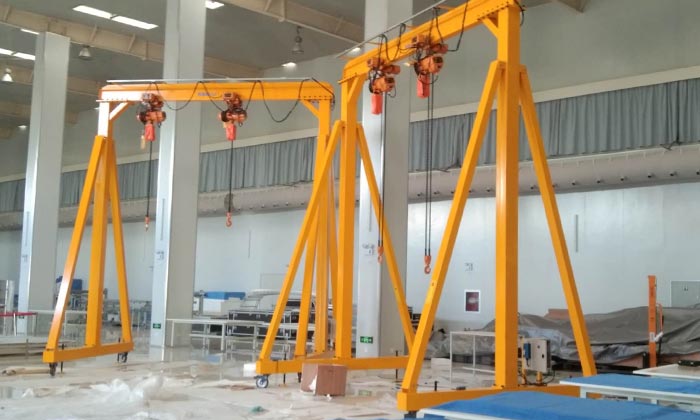
Steel Portable Gantry Crane with Double Hoists and Double Hooks
Overview:
- Construction Material: Fabricated primarily using steel components known for their strength and durability.
- Double Hoists and Hooks: Equipped with two hoists and double hooks, allowing simultaneous or independent lifting of multiple loads.
Features:
- Sturdy Design: Robust steel construction provides stability and high load-bearing capacity.
- Versatility: Suited for heavy-duty lifting tasks and rugged industrial environments.
Applications:
- Heavy Industries: Ideal for steel mills, manufacturing plants, and construction sites handling heavy materials or machinery.
- Outdoor Use: Suitable for outdoor applications due to steel's resilience against weather and harsh conditions.
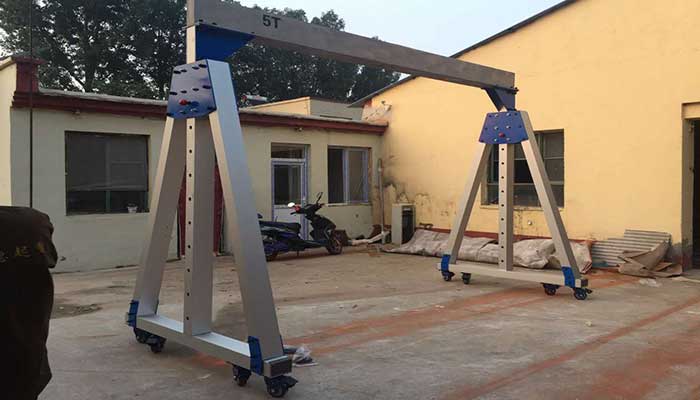
Aluminum Portable Gantry Crane with Double Hoists and Double Hooks
Overview:
- Construction Material: Manufactured using lightweight yet robust aluminum components.
- Double Hoists and Hooks: Similar to steel gantry cranes, equipped with two hoists and double hooks for versatile lifting.
Features:
- Portability: Lightweight construction allows for easy transportation and setup in various locations.
- Corrosion Resistance: Aluminum's natural resistance to corrosion suits environments susceptible to rust or chemical exposure.
Applications:
- Clean Environments: Suitable for clean room operations or industries where avoiding contamination is crucial.
- Temporary or Changing Work Sites: Ideal for job sites requiring frequent relocation due to its lightweight and easy assembly.
Comparison:
Strengths:
Steel Gantry Crane:
- Offers high strength and load-bearing capacity.
- Suited for heavy-duty industrial applications.
Aluminum Gantry Crane:
- Lightweight and easy to transport.
- Resistant to corrosion, suitable for specific environments.
Considerations:
Steel Gantry Crane:
- Heavier, might require additional equipment for transportation.
- Ideal for applications prioritizing strength and durability.
Aluminum Gantry Crane:
- Lightweight but may have lower load capacities compared to steel.
- Suited for applications where portability and corrosion resistance are paramount.
Both steel and aluminum portable gantry cranes with double hoists and double hooks offer distinct advantages based on their construction materials. The choice between the two depends on specific industrial needs, considering factors such as load capacities, portability requirements, environmental conditions, and durability expectations.
Double Hoist Gantry Cranes: Design and Functionality
Double hoist gantry cranes possess unique characteristics that distinguish them in terms of design, functionality, and application:
Portability and Usage in Open Spaces:
- Versatility in Mobility: Double hoist gantry cranes offer portability, allowing them to be moved and deployed across various locations within a facility or in outdoor environments. Their mobility makes them suitable for use in areas lacking fixed overhead support structures.
- Operation in Open Spaces: These cranes are well-suited for open spaces where traditional overhead crane systems might not be feasible. Their gantry structure provides support without relying on building infrastructure, making them adaptable to outdoor environments like construction sites or storage yards.
- Advantages over Fixed Overhead Systems: Compared to fixed overhead cranes, double hoist gantry cranes offer mobility and flexibility in deployment. They don't depend on permanent structures, providing versatility in their usage across various work areas.
The design and functionality of double hoist gantry cranes offer unique advantages in terms of mobility, adaptability to open spaces, and flexibility in deployment. Their application in diverse industries showcases their effectiveness in providing solutions where traditional fixed overhead systems might be limited.
Safety Innovations in Double Hoist Overhead Cranes and Double Hoist Gantry Cranes
Safety remains a paramount concern in the design and operation of double hoist overhead cranes. Continuous advancements in technology have introduced several cutting-edge safety features and systems, ensuring a secure working environment. Some of the latest safety enhancements include:
Anti-Collision Systems:
- Advanced Collision Detection: Integration of sensors and proximity detection systems to prevent collisions between cranes or with obstacles.
- Automated Safety Measures: Real-time monitoring and automated intervention to stop crane movements in case of potential collisions.
Emergency Braking Mechanisms:
- Instant Braking Systems: Implementing emergency braking systems that engage instantly upon detection of anomalies or unsafe conditions.
- Fail-Safe Controls: Ensuring fail-safe mechanisms that halt crane movements immediately during emergency situations.
Compliance with Industry Safety Standards:
- Regulatory Adherence: Ensuring strict compliance with international safety standards such as OSHA, CMAA, and ISO, certifying the crane's adherence to safety regulations.
- Safety Training and Manuals: Providing comprehensive safety training for operators and clear, detailed safety manuals for reference.
Load Monitoring and Control:
- Load Limiters and Sensors: Incorporating load monitoring systems equipped with sensors to prevent overloading and ensure safe lifting capacities.
- Smart Control Systems: Introducing intelligent control interfaces that notify operators of load deviations and provide real-time feedback for safe load handling.
Redundancy Systems:
- Backup Controls: Implementing redundant safety systems and backup controls to ensure continued operation even in the event of primary system failure.
- Power Failure Safeguards: Ensuring fail-safe procedures for power failures to prevent accidents during unexpected outages.
Safety Audits and Inspections:
- Regular Inspections: Conducting routine safety inspections and audits to verify the functionality and adherence of safety mechanisms.
- Maintenance Protocols: Implementing strict maintenance schedules to ensure continuous operational safety.
The integration of these latest safety innovations in double hoist overhead cranes signifies a concerted effort toward ensuring a secure working environment. By adhering to industry safety standards and incorporating advanced safety features, these cranes provide operators and businesses with the confidence and assurance of a safe and secure lifting operation.
Considerations for Installation and Maintenance
Installation and maintenance of double hoist cranes require meticulous planning and adherence to specific procedures to ensure optimal performance and safety:
Site Preparation and Structural Requirements:
- Site Assessment and Preparation: Before installation, conducting a thorough site assessment is crucial. Ensure that the installation site meets structural and spatial requirements to support the crane's weight and operations.
- Structural Integrity: Verify that the supporting structures, such as columns or beams, are capable of withstanding the crane's weight and operational stresses. Strengthening or modifications might be necessary to ensure structural integrity.
Routine Maintenance and Inspections:
- Scheduled Maintenance: Implement routine maintenance schedules to ensure the crane's proper functioning. Regular checks on components like ropes, chains, hoists, and electrical systems are essential to identify and rectify any issues promptly.
- Inspections and Servicing: Conduct thorough inspections in compliance with manufacturer guidelines and industry standards. Address any signs of wear, corrosion, or mechanical faults promptly. Regular servicing by qualified technicians is crucial for optimal crane performance.
Training and Operator Proficiency:
- Operator Training Programs: Provide comprehensive training programs for crane operators. Training should cover crane operation, safety protocols, emergency procedures, and maintenance awareness to ensure safe and efficient handling of the equipment.
- Operator Proficiency: Regularly assess operator proficiency to ensure ongoing competency in operating the crane. Refreshers on safety protocols and operational procedures should be conducted periodically to maintain proficiency levels.
Installation and maintenance considerations are critical for the safe and efficient operation of double hoist cranes. Proper site preparation, routine maintenance, inspections, and ensuring operator proficiency are essential to maximize the crane's longevity and performance while ensuring a safe working environment.
Cost Analysis and Budgeting for Double Hoist Cranes
Assessing the costs and budgeting for double hoist cranes involves considering various factors, including initial investment, long-term savings, pricing factors, and financing options:
Initial Investment vs. Long-Term Savings:
- Initial Investment Considerations: Evaluate the upfront costs associated with purchasing and installing a double hoist crane. Consider factors such as crane type, capacity, customization, and installation expenses.
- Long-Term Cost Savings: Assess the potential long-term savings offered by the crane's efficiency, reduced labor costs, minimized downtime, and improved productivity. Compare these savings against the initial investment to gauge the crane's overall cost-effectiveness.
Factors Affecting Pricing:
- Customizations and Features: Different configurations, additional features, and customizations impact the pricing of double hoist cranes. Assess specific requirements and their associated costs to determine the most suitable options.
- Maintenance and Service Costs: Consider the ongoing maintenance and service costs required to ensure the crane's optimal performance. Factor in routine inspections, spare parts, and servicing expenses for accurate budgeting.
Financing Options and ROI Assessment:
- Exploring Financing Solutions: Investigate various financing options available for procuring double hoist cranes. Options such as leases, loans, or financing packages could help manage initial costs and align payments with operational benefits.
- Assessing Return on Investment (ROI): Calculate the potential ROI by comparing the initial investment against projected long-term savings and operational improvements. A thorough assessment of ROI assists in determining the crane's overall value to the business.
Analyzing the costs associated with double hoist cranes involves considering not only the initial investment but also long-term savings, factors influencing pricing, and available financing options. A comprehensive cost analysis and ROI assessment aid in making informed decisions, ensuring the crane's affordability and cost-effectiveness over its lifespan.
Wrap it Up,
The implementation of double hoist cranes presents a range of benefits and diverse applications across various industries, offering significant advantages in operational efficiency and safety:
Recap of Benefits and Applications:
- Operational Advantages: Double hoist cranes offer increased lifting capacity, enhanced efficiency in material handling, and versatility in operations, contributing to optimized workflow, productivity, and safety improvements in industrial settings.
- Applications Across Industries: From manufacturing and construction sectors to warehousing and logistics, double hoist cranes play pivotal roles in production, construction, inventory management, and cargo handling, showcasing their adaptability across diverse industrial applications.
Final Considerations for Prospective Buyers and Users:
- Assessing Specific Requirements: Prospective buyers and users should meticulously assess their operational needs, considering factors like lifting capacities, precision, safety features, and portability requirements to select the most suitable double hoist crane.
- Cost-Benefit Analysis: Conduct a comprehensive cost-benefit analysis to evaluate the initial investment against long-term savings and operational improvements. This assessment aids in determining the crane's value proposition for the business.
- Operator Training and Maintenance: Prioritize operator training programs and adhere to routine maintenance schedules to ensure safe and efficient crane operations. Regular maintenance and operator proficiency are critical for optimal crane performance.
In conclusion, the utilization of double hoist cranes in industrial settings offers multifaceted benefits and extensive applications. Their efficiency in material handling, adaptability across industries, and safety improvements underline their significance in enhancing operational efficiency and safety culture within industrial environments.
Prospective buyers and users should carefully consider specific operational requirements, conduct cost-benefit analyses, and prioritize safety and maintenance protocols to harness the full potential of double hoist cranes within their industrial setups.
Related Products

Latest project
150 Ton Overhead Crane Installation Feedback – Paraguay Case
QDX 150 ton overhead crane in action in Paraguay. Installation photos, video, and client feedback show performance, safety, and heavy-lifting efficiency.
Free consultation to Confirm Parameters & Specifications and Get
Latest Crane Price & Crane Rate.
- Types of overhead cranes : _______?
- Optional: Overhead travelling crane, goliath gantry crane,Slewing jib crane, Single girder or double girder crane,small portable crane or kbk crane, etc.
- Capacity of overhead crane: _______?
- Optional: 0.25ton, 0.5 ton, 1 ton, 2 ton, 3ton, 5 ton, 10 ton,15ton, 20ton, 25 ton, 30ton,35ton, up to 550ton, etc.
- Crane span & lifting height : _______?
- Crane travelling length : _____?
- Control of overhead crane:_______?
- Optional: pendant/ remote/cabin control
- Voltage supply of overhead crane:_____?
- Eg,: 380V50/60HZ,3Phase or others,etc.
- Application/usage of crane:_______?
- Eg,: Steel mill, ,injection mold, cement,stone, concrete,granite, general manufacturing, etc.
Just leave a message via the contact form and our hoist and crane engineer will contact you with in 24working hours.
Get In Touch
